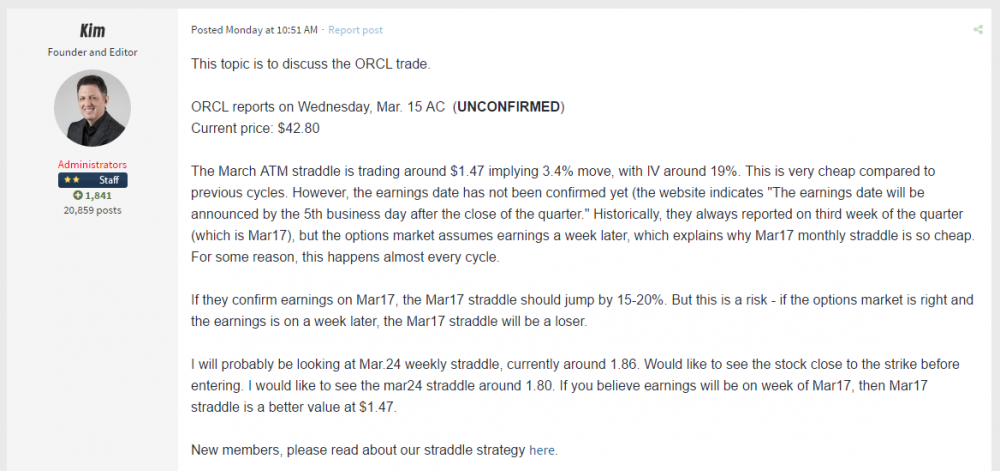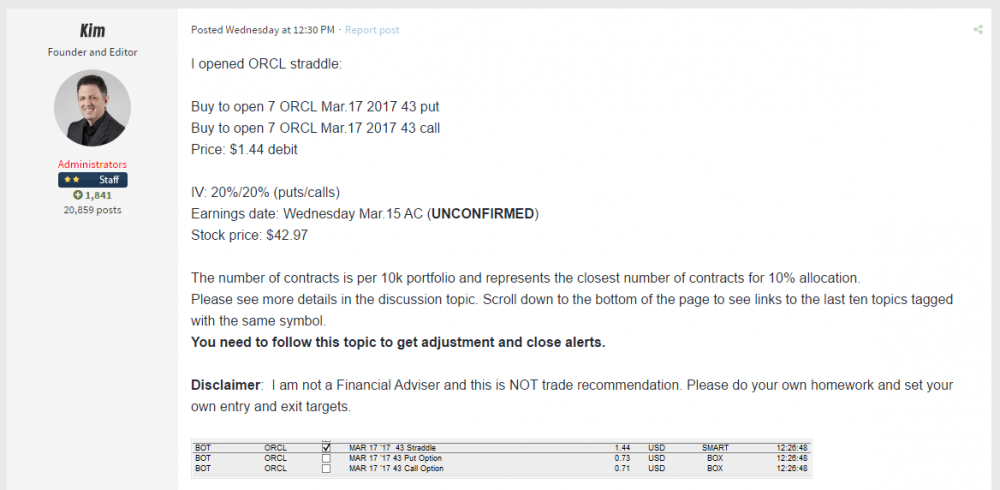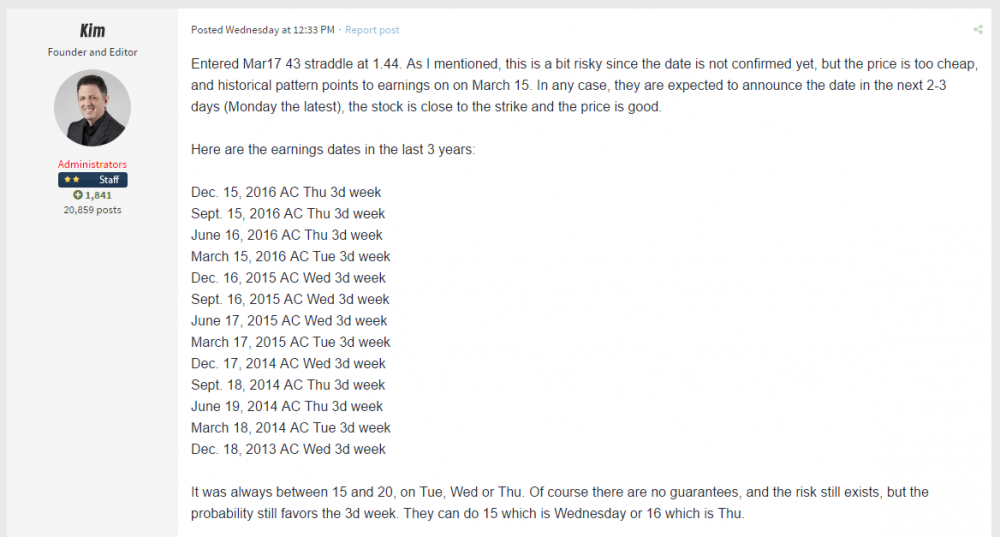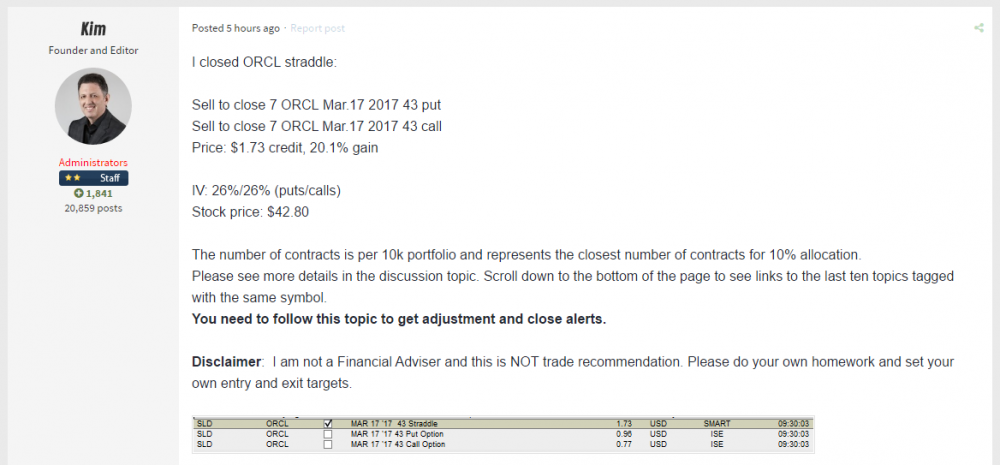
Oracle (ORCL) has been following a similar pattern in the last few years. They announce their earnings date on the first week of the third month of the quarter and report during the third week of the month. Yet many times the options market "assumes" earnings during the fourth week and under-prices the third week options.
This cycle was no exception.
It is a well known fact that Implied Volatility of options increases before earnings. We usually take advantage of this phenomenon by buying a straddle option few days before the earnings date.
However, Oracle case was slightly different. As I mentioned, they follow a similar pattern of earnings dates in the last few years (third week of the month), but for some reason, the options market tends to be "surprised" after the earnings date is actually confirmed.
On February 27 I opened ORCL trade discussion topic and posted the following information:

My initial intention was to trade the Mar.24 straddle, which would be a safer bet.
However, after checking again the previous cycles and seeing the Mar.17 straddle dipping below $1.45, I decided to take the risk and execute the Mar.17 straddle. The trade has been posted on the forum on Mar.01:

I posted the rationale for selecting the Mar.17 expiration, with all supporting information, including the risks:

Two days later, Oracle confirmed earnings on Mar.15, as expected.

IV of Mar.17 options jumped 4 points after the date has been confirmed, and we closed the trade for 20.1% gain.

This is a great example how we make Implied Volatility to work for us. We implement few strategies that take advantage of Implied Volatility changes around the earnings event.
Of course, this trade was not without risks. If earnings were confirmed on week of Mar.24, the Mar.17 straddle could easily lose
40%. But options trading is a game of probabilities. Based on previous cycles, I estimated that there was
90% chance that earnings will be on week of Mar.17. Making 20% 9 out of 10 times and losing 40% in one trade still puts you far ahead, with 140% cumulative gain. I also provided members all the necessary information so everyone could make an educated decision.
At SteadyOptions, the learning never stops. If you think education is expensive, try ignorance.
Want to learn more?
What Is SteadyOptions?
Full Trading Plan
Complete Portfolio Approach
Diversified Options Strategies
Exclusive Community Forum
Steady And Consistent Gains
High Quality Education
Risk Management, Portfolio Size
Performance based on real fills
Non-directional Options Strategies
10-15 trade Ideas Per Month
Targets 5-7% Monthly Net Return
Recent Articles
Articles
Pricing Models and Volatility Problems
Most traders are aware of the volatility-related problem with the best-known option pricing model, Black-Scholes. The assumption under this model is that volatility remains constant over the entire remaining life of the option.
By Michael C. Thomsett, August 16

- Added byMichael C. Thomsett
- August 16
Option Arbitrage Risks
Options traders dealing in arbitrage might not appreciate the forms of risk they face. The typical arbitrage position is found in synthetic long or short stock. In these positions, the combined options act exactly like the underlying. This creates the arbitrage.
By Michael C. Thomsett, August 7

- Added byMichael C. Thomsett
- August 7
Why Haven't You Started Investing Yet?
You are probably aware that investment opportunities are great for building wealth. Whether you opt for stocks and shares, precious metals, forex trading, or something else besides, you could afford yourself financial freedom. But if you haven't dipped your toes into the world of investing yet, we have to ask ourselves why.
By Kim, August 7

- Added byKim
- August 7
Historical Drawdowns for Global Equity Portfolios
Globally diversified equity portfolios typically hold thousands of stocks across dozens of countries. This degree of diversification minimizes the risk of a single company, country, or sector. Because of this diversification, investors should be cautious about confusing temporary declines with permanent loss of capital like with single stocks.
By Jesse, August 6

- Added byJesse
- August 6
Types of Volatility
Are most options traders aware of five different types of volatility? Probably not. Most only deal with two types, historical and implied. All five types (historical, implied, future, forecast and seasonal), deserve some explanation and study.
By Michael C. Thomsett, August 1

- Added byMichael C. Thomsett
- August 1
The Performance Gap Between Large Growth and Small Value Stocks
Academic research suggests there are differences in expected returns among stocks over the long-term. Small companies with low fundamental valuations (Small Cap Value) have higher expected returns than big companies with high valuations (Large Cap Growth).
By Jesse, July 21

- Added byJesse
- July 21
How New Traders Can Use Trade Psychology To Succeed
People have been trying to figure out just what makes humans tick for hundreds of years. In some respects, we’ve come a long way, in others, we’ve barely scratched the surface. Like it or not, many industries take advantage of this knowledge to influence our behaviour and buying patterns.

- Added byKim
- July 21
A Reliable Reversal Signal
Options traders struggle constantly with the quest for reliable
By Michael C. Thomsett, July 20

- Added byMichael C. Thomsett
- July 20
Premium at Risk
Should options traders consider “premium at risk” when entering strategies? Most traders focus on calculated maximum profit or loss and breakeven price levels. But inefficiencies in option behavior, especially when close to expiration, make these basic calculations limited in value, and at times misleading.
By Michael C. Thomsett, July 13

- Added byMichael C. Thomsett
- July 13
Diversified Leveraged Anchor Performance
In our continued efforts to improve the Anchor strategy, in April of this year we began tracking a Diversified Leveraged Anchor strategy, under the theory that, over time, a diversified portfolio performs better than an undiversified portfolio in numerous metrics. Not only does overall performance tend to increase, but volatility and drawdowns tend to decrease: